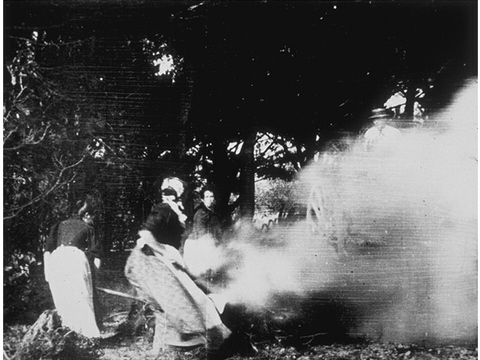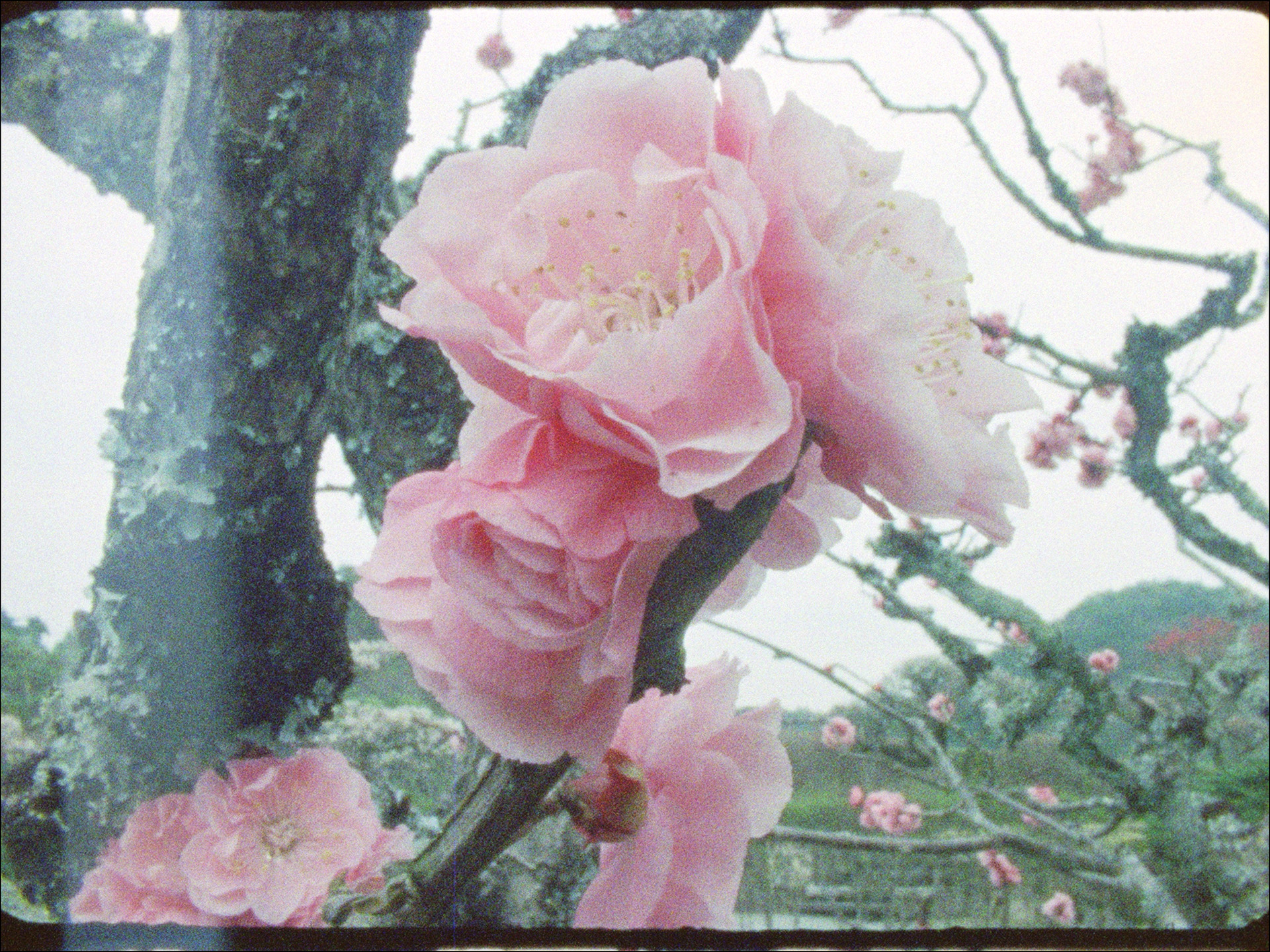An Entanglement of Weeds and Film
Teresa Castro
“The wisdom of the plants,” wrote Gilles Deleuze and Félix Guattari, is that “even when they have roots, there is always an outside where they form a rhizome with something else—with the wind, an animal, human beings.”{1} Relying on microbial mediators, symbiotic fungi, pollinating insects, human and other-than-human cultivators, gushes of wind, plants, and in particular proliferating and protean weeds remind us that life is a matter of partnerships, connections, and tangles. This essay will explore some of the enmeshments that have brought weeds and film together. Standing for the alien, the undesirable, the out of place, weeds have a bad reputation: they can reduce yields, harbor insects, foster diseases, poison livestock, and wreck entire ecosystems. Fueling narratives of fear and safety, weeds nourish fantasies of pristine ecologies: discourses on “immigrant” plants and “biological invasions” are rife with fear-mongering metaphors. But “vagabond plants” are also the “guardians of the soil, the wanderers who dare live in disturbed lands.”{2} They can restore minerals and nutrients, healing damaged lands and human bodies alike. They are the vegetal allies that some still know how to use and prepare, how to weave. Moreover, they might be fitting companions for those who grow in between. Those who run athwart, infusing wildness and diversity into all sorts of prevailing monocultures; those who prosper in the fissures and cracks of dominant discourses; those who invite us to read against the grain. How can weeds, understood here as a token for the multiple and the decentered, help us think about our own entangled condition? To appropriate the title of a famous Donna Haraway interview (“How Like a Leaf”), how like weeds are we?{3} And how can our shared condition help us imagine new affective ecologies with such unusual companions?
 MAUVAISES HERBES (Auguste Lumière, 1896). “Women burn the heaps of weeds in a field and turn them over with pitchforks.” Image courtesy of Catalogue Lumière.
MAUVAISES HERBES (Auguste Lumière, 1896). “Women burn the heaps of weeds in a field and turn them over with pitchforks.” Image courtesy of Catalogue Lumière.
Viewed by most as a human-centered medium, film usually measures its shots to human bodies and human time scales. Despite the suggestive fact that in 1896 Auguste Lumière made a film called Mauvaises herbes, weeds rarely make it to the foreground (Lumière’s real subject, by the way, was not weeds but rising swirls of evanescent white smoke). In those early days, weeds lacked the attractiveness of rustling leaves, rolling waves, or even blazing oil gushers (see the Lumière brothers’ Oil Wells of Baku, also shot in 1896). Unsurprisingly, it was time-lapse—in many respects a powerful technology of encounter—that made a real subject out of weeds. By reconciling human and other-than-human temporalities, it revealed an intentional actant behind the “lowest” plant. “If I think anything is a pest, I make a film about it; then it becomes beautiful,” acknowledged British naturalist and early nature documentary pioneer Frank Percy Smith.{4} In 1930, along with Mary Field, he devoted a picture to the dodder, a rootless parasitic weed with little to no chlorophyll, also known as wizard’s net, devil’s hair, or strangletare. The Strangler (1930), as Field and Smith write, presents him as a villain: “We see him, an unfamiliar, sinister, snakelike vegetable vampire, ravaging beautiful plants with which we are acquainted and upon which we unhesitatingly bestow our sympathies.”{5} As hinted at by the choice of a gendered pronoun (in reality, the dodder is a hermaphroditic angiosperm), one of the characteristics of the Secrets of Nature documentary series to which the film belongs is its blatant anthropomorphism, emphasized, from 1929 onward, by the voiceover and the Mickey Mousing of the accompanying music.{6} All sorts of creatures, from sea birds and insects to slime mold and weeds, are enlivened with passions and purposes. In many respects, Field and Smith’s “ciné-biology”—“the study of life through the medium of cinema”—is an animating project, where the other-than-human sphere is envisaged in intentional and mentalistic terms.{7} On the amusing topic of “plants as film stars,” they remarked that “a plant makes up its own mind—or whatever Nature has given it in place of a mind—as to the programme it intends to carry out,” concluding that “our wisest plan is to allow the plant to tell its story in its own way, while optically accelerating its slow and dignified progress to conform with the requirements of the age of speed.”{8}
THE STRANGLER (Frank Percy Smith, 1930).
Filmic attempts to move beyond human-centered frameworks have come a long way since Smith, Field, and others shot their astonishing documentaries in Smith’s home, which, by the end of the 1920s, had been conquered by some of the series’ other-than-human stars, mold covering the drawing-room walls and weeds growing amok in the garden.{9} The films of Smith and Field confirm what French filmmaker Jean Painlevé wrote in 1947: “It never would have occurred to the pioneers of cinema to dissociate research on film from research by means of film.”{10} Precisely, the dodder’s character in The Strangler relies on cinematic means: shot scales and scale collision, figure-ground articulation, time-lapse, editing. Acceleration of time in particular has the capacity to make the plant “speak in active voice,” as Australian philosopher and ecofeminist Val Plumwood would put it.{11} To “speak in active voice” means here to depict nature in the domain of agency, and has nothing to do with the film’s melodramatic comment, which sounds problematic to the modern ear. If the dodder is an “obligate parasite” (it can’t survive without a host), calling it a “natural born strangler” doesn’t take us very far beyond anthropocentrism (additionally, if dodders weaken their hosts, in their native environments they rarely kill them).
Fashioning the dodder as a botanical thug was, however, a box-office strategy: “Stoking speculation about animal emotions or plant sentience was seen as good publicity.”{12} As Caroline Hovanec remarks, “Turn the sound off and The Strangler becomes a completely different work.”{13} Twining around its victims like a snake, planting its suckering spikes on the host, the dodder invites us to question species and kingdom boundaries and to wonder at the dodder’s uncanny abilities. Even today, the widespread Cuscuta genus to which the dodder belongs remains little known: more studies exist on plant-microbe interaction than on the interaction between parasitic plants and their hosts. Smith went to great lengths to grow and to film plants, under and above ground, devoting one or two years to the shooting of particular specimens. His efforts paid off, and if The Strangler “aroused little enthusiasm” among its human audience (the dodder is not your usual botanical subject), spectators were genuinely taken aback by the series’ disclosure of the aliveness of plants.{14} Referring to another picture (The Life of a Plant, 1926, starring a garden nasturtium) a reviewer commented that “you find it difficult to believe . . . that the life of a plant is not as sentient as your own.”{15} For this and other reasons (including Field and Smith’s fascinating writings on ciné-biology), the series has been inscribed into “a lineage of biocentric thought that runs from Darwin to deep ecology to contemporary ecocritical theory.”{16}
Choosing a parasitic weed as a subject necessarily entails thinking about interspecies encounters. Most time-lapse plant films focus on individual plants; The Strangler is literally about dodders involving themselves in other plants’ lives. Despite the stultifying narrative of its voiceover, the film opens up to the question of interspecies relationality. The latter is at the center of what historian Carla Hustak and anthropologist Natasha Myers call “affective ecologies”: the “affective push and pull among bodies, including the affinities, ruptures, enmeshments, and repulsions among organisms constantly inventing new ways to live with and alongside one another.”{17} In their article Hustak and Myers concentrate on orchid-insect scientific accounts, demonstrating how Charles Darwin himself, with his penchant for imitation, became a participant in his own orchid experiments. Unhinging the legacy of evolutionary theories, they reclaim an “involutionary” mode of attention, capable of recognizing “pleasure, play or improvisation within and among species.”{18} Most importantly, Hustak and Myers disclose the interdependence of seemingly unrelated life forms.
 SHAPE SHIFTING (Mikhail Lylov and Elke Marhöfer, 2015).
SHAPE SHIFTING (Mikhail Lylov and Elke Marhöfer, 2015).
Some of the most interesting cinematographic attempts to break free from anthropocentric frameworks and observation modes equally rely on affective ecologies. Soils-Habit-Plants (2017), a short film by Mikhail Lylov and Elke Marhöfer, employs a macro lens to film the earth where, among others, wild millet and Japanese knotweed grow.{19} Effectively moving beyond perspectival form and logocentric knowledge, the film exercises its own involutionary mode of attention, characterized here by its unstable use of focus (the soil close-ups are mostly out of focus). Lylov describes how he and Marhöfer involved themselves haptically and erotically with the soil, caressing it with the camera:
If we speak of pleasure as a physical experience, filming plants and soil—in macro with no tripod—requires a lot of physical concentration and guessing. You are moving the camera, trying to follow the curve of a leaf or a soil particle, which induces an extremely strange state of the body. It’s like you are maintaining a sense of touch on the verge of the sensible.{20}
Thinking of a different film (Shape Shifting, 2015), Marhöfer explains that she likes “to understand the camera as a machinic companion.” The artist remarks that “companions transform one another” and that “their entanglement with the environment from which they emerge forms them.” “This companionship,” she adds, “overlaps perspectives of the environment, the camera, and the human. It creates a diversity of sensations and temporalities and activates relational modes of perception.”{21}
Mapping onscreen the enmeshments and intimacies that bind together humans and other-than-humans such as weeds—what Shape Shifting does by delving into the Japanese satoyama (the border zone or area between mountain foothills, yama, and the arable flat land next to the villages, sato)—Lylov and Marhöfer show us that exploring the other-than-human by means of film is already a means of shaping affective relationships encompassing human and machinic fellows. The joyful myriad of other-than-human agents potentially implicated are far from being limited to organic actants: in Soils-Habit-Plants, the camera’s tremulousness, as well as the rapid editing of close-up shots of wild millet, evokes the collaboration of the wind.{22} Both Soils-Habit-Plants and Shape Shifting remind us that other-than-human subjects hint at specific modes of sensing, feeling, affecting, and being affected. Filming here means attuning human makers and human spectators to the sensibilities of the soil, weeds, and wind. In this sense, both films are experiments in becoming with, a matter of alliances and counter-encounters.
Why nurture connections with weeds? Why would humans want to cultivate such unusual attachments, instead of drowning weeds in herbicides or (since weeds are extraordinarily resistant) blowtorching them? Standing at the opposite end of the scale from the orchids that Darwin loved so much, the archetypal weed lacks their pedigree, their rareness, their sophisticated beauty. Unlike orchids, weeds are “vulgar” and less capable of capturing human respect. Moreover, they don’t seem threatened by extinction: they thrive across damaged lands, haunting the landscapes of the Anthropocene, sometimes pushing other (native, scarcer) species to the brink of disappearance. Precisely: weeds tell of “small, partial, and wild stories of more-than-human attempts to stay alive.”{23} The tangled, split, and venturesome histories that we need to imagine in order to sow worlds, to terraform with Earth Others—in short, in order to stay with trouble—are likely to involve weeds.{24} Weeds not only dispute the nature-culture divide (they are the offspring of colonizing and imperial histories, an emblem of natural-cultural degradation); their histories are histories of becoming with human beings. Likewise, human histories are histories of becoming with weeds.
Title video: The Strangler (Frank Percy Smith, 1930).
{1} Gilles Deleuze and Félix Guattari, A Thousand Plateaus: Capitalism and Schizophrenia, trans. Brian Massumi (Minneapolis: University of Minnesota Press, 1987), 11.
{2} See Gilles Clément, “In Praise of Vagabonds,” trans. Jonathan Skinner, Qui Parle 19, no. 2 (Spring/Summer 2011): 275–97; and Joseph A. Cocannouer’s classic Weeds: Guardians of the Soil (New York: Devin-Adair, 1950).
{3} Donna J. Haraway, How Like a Leaf: An Interview with Thyrza Nichols Goodeve (New York: Routledge, 2000).
{4} O. Blakeston, “Personally about Percy Smith,” Close-Up 8, no. 2 (June 1931): 144.
{5} Mary Field and Percy Smith, Secrets of Nature (London: Scientific Book Club, 1939), 164. Smith and Field would’ve been pleased to learn that the dodder seems to compensate for its parasitism by functioning as a communication network: recent studies have suggested that host plants linked by the weed use it as a chemical bridge to signal and exchange information.
{6} Produced by British Instructional Films, the series Secrets of Nature released 144 documentaries between 1922 and 1933; out of these, 39 films focused on the plants. The series was extremely popular and seems to have left its imprint on later productions, such as David Attenborough’s The Green Planet (BBC, 2022). On Secrets of Nature, see, among others, Max Long, “The ciné-biologists: natural history film and the co-production of knowledge in interwar Britain,” British Journal for the History of Science 53, no. 4 (2020): 527–51.
{7} Mary Field, J. Valentine Durden, and F. Percy Smith, See How They Grow: Botany through the Cinema (London: Pelican, 1952), viii.
{8} Field and Smith, Secrets of Nature, 148.
{9} Linda Rodriguez McRobbie, “The Shy Edwardian Filmmaker Who Showed Nature’s Secrets to the World,” Atlas Obscura, February 21, 2017.
{10} Jean Painlevé, “Scientific Film,” in Science Is Fiction: The Films of Jean Painlevé, ed. Andy Masaki Bellows, Marina McDougall, and Brigitte Berg (Cambridge, MA: MIT Press, 2001), 162.
{11} Val Plumwood, “Nature in the Active Voice,” Australian Humanities Review, no. 46 (May 2009): 113–29.
{12} Long, “The ciné-biologists,” 10.
{13} Caroline Hovanec, “Another Nature Speaks to the Camera: Natural History and Film Theory,” Modernism/Modernity 26, no. 2 (April 2019): 258.
{14} Field and Smith, Secrets of Nature, 162.
{15} Quoted in Long, “The ciné-biologists,” 9.
{16} Hovanec, “Another Nature Speaks,” 246.
{17} Carla Hustak and Natasha Myers, “Involutionary Momentum: Affective Ecologies and the Sciences of Plant/Insect Encounters,” differences: A Journal of Feminist Cultural Studies 23, no. 3 (2012): 97.
{18} Hustak and Myers, 77.
{19} The wild relative of millet that we see in the film (shot in Japan) is today considered a particularly resistant weed. Likewise, Japanese knotweed (introduced in Europe as a garden shrubbery in the mid-nineteenth century) is often described as a particularly virulent biohazard.
{20} “Soils-Habit-Plants: Mikhail Lylov and Elke Marhöfer in conversation with Sahar Qawasmi and Nida Sinnokrot,” e-flux, September 2020. See also Makoto Mochida, “I is an-other… Eroticism in Marhöfer and Lylov’s film Soils_Habit_Plants,” Elke Marhöfer (website), accessed September 9, 2022.
{21} Martin Grennberger, “Ten Questions: Elke Marhöfer,” Kunstkritikk, August 31, 2016.
{22} An intuition shared by Nida Sinnokrot. See “Mikhail Lylov and Elke Marhöfer in conversation.”
{23} Anna Tsing, Heather Swanson, Elaine Gan, and Nils Bubandt, “Introduction: Haunted Landscapes of the Anthropocene,” in Arts of Living on a Damaged Planet: Ghosts and Monsters of the Anthropocene, ed. Tsing, Swanson, Gan, and Bubandt (Minneapolis: University of Minnesota Press, 2017), 6.
{24} An obvious reference to Donna J. Haraway, Staying with the Trouble: Making Kin in the Chtulucene (Durham, NC: Duke University Press, 2016).

